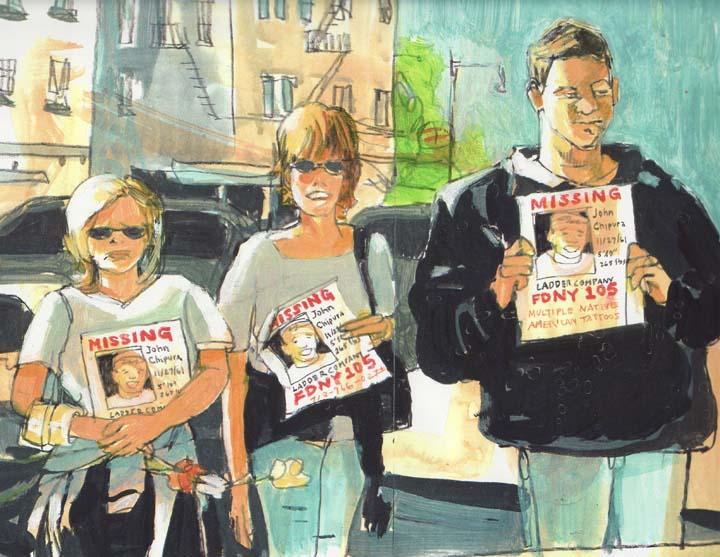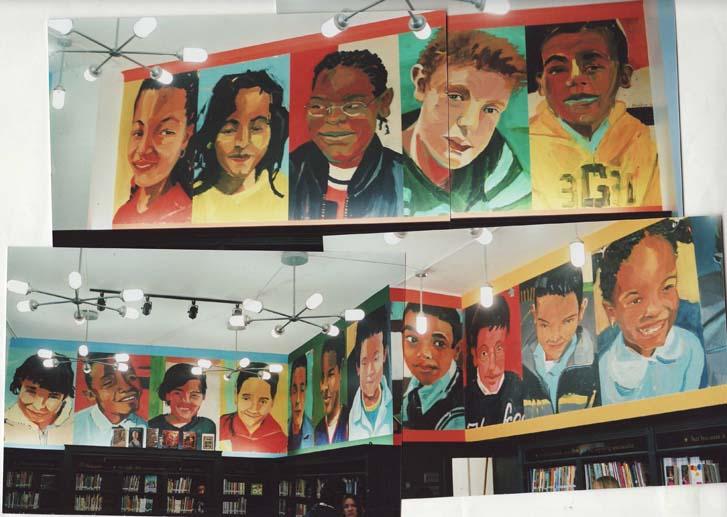Lynn Pauley Live on ProjectNorman
The Norman Rockwell Museum Digital Collection, which was originally created to make the work of an iconic American artist accessible, has been expanded to include works by other artists. This online searchable database, ProjectNorman, now includes works by such artists as N.C. Wyeth, James Montgomery Flagg, and William Steig, to name a few.
Last week, a major collection of artwork by Lynn Pauley went live on ProjectNorman. Pauley, known for her on-the-scene visual reports on situations as varied as the 1995 Oklahoma City bombings to Thoroughbred horse racing and New York City street life, did this exclusive Q&A for DART readers.
Q: I read your story about moving into a new studio on Union Square in 2001 and soon after that finding yourself without any substantial commissions for a year following the 9/11 attacks. How did you arrive at the idea of archiving your work at that time?
A: During the time of the attacks and just after 9/11, F-16's flew overhead and all of the major thoroughfares in and out of the city—the Holland and the Lincoln Tunnels, and the bridges—were closed. But the subways kept running. On September 12th I was able to get into my studio and a brand new computer that I had ordered a week before was delivered. When I asked the trucker how he got into the city he said that the truck was already here.
So after a day or so I walked and used the subways to get downtown. Back in my studio, I made about 28 paintings and wrote a story about what was happening in the city at that time. I think I completed 28 images in four days, which I then presented as a whole package to Print Magazine (Editor: Joyce Rutter Kaye, Art Director: Steven Brower). They published the entire piece.

Silently hoping and waiting for any word, outside St. Vincent's Hospital
NYC
My studio was on the north end of Union Square; everything below 14th Street was blockaded. You were required to present ID to get to your homes or businesses. I am a half full type of gal and I soon realized that I was going to have an abundance of free time. I had handwritten all of the background stories from the Oklahoma City bombing, my time at the Arkansas Derby, and the Masters Tournament. People had told me stories about an unusual toy museum, and I had listened in on overheard conversations and met locals and visitors when I was in Florida at Christmas time. People are always telling me stories. For some reason, perfect strangers sense that I am a trustworthy and a good listener. So after Print magazine published that visual essay, I started to write up my stories and gather the illustrations for what would become the Visual American website. I worried that I would forget the specifics about my post-9/11 experiences; that year without much freelance work gave me the opportunity to archive my work.
Q: How did you find the strength to keep going on this for—was it an entire year? When did the work situation begin to turn around for you?
A: I am extremely self-directed. My training has taught me to always make pictures whether I have an assignment or not. This is a practice that I continue to this day. I started making collages from found items at that time, (I have 400 now) and I kept working on large mixed media sign images. I had small exhibits in Brooklyn with the signs, and I taught at various schools. I just kept making art and writing every day. From being in the business as long as I had, I had tremendous faith that it would all work out.
 The Barker Character,
Comic & Cartoon Museum, Cheshire, Connecticut.
The Barker Character,
Comic & Cartoon Museum, Cheshire, Connecticut.
I also kept talking to people. Over time I have built up relationships with people in the industry. I would say the turning point was around 2002, or early 2003, when The Robin Hood Library Initiative decided they were going to fund various underperforming schools in the NYC area with brand new libraries. They enlisted well-known architects to design and build state of the art facilities to which they also donated new books and computers. Michael Bierut, a partner in Pentagram Design, who has always been a champion of my work, was brought on board and commissioned me to create four original wraparound murals for PS 36, PS 86, PS 246, and PS 94—all in the Bronx. I created images using acrylic and pencil (which is my “bread and butter” technique) and also did a mural using collage and found items (the students collected 3,000 items on a scavenger hunt that I organized).
Q: The Norman Rockwell Museum began ProjectNorman in 2003, a few years after you created your archive. How did the idea for the donation of your work to the Museum evolve?
A: I have been a friend and professional colleague of Stephanie Plunkett at the Norman Rockwell Museum for about 20 years. I was intrigued with ProjectNorman, a program
through which the Museum was quietly amassing works by contemporary illustrators as an online legacy collection for the next generation of students and graphic arts professionals. So after mounting
The Visual American website, I realized I had hundreds of originals, studies, and sketchbooks from assignments in boxes in a storage unit.
Three hundred of those images were line
drawings done on site for the New York Times Metro Section. There were the original paintings I did on site covering the Oklahoma City Bombing, in 1995. We are in a new age of
communication, a quiet explosion of artists literally living and communicating and promoting online. I love the idea that anyone—students, colleagues, the general public—can have
access to my work online. I donated 730 images, which went live last week.
 Acrylic
Portraits Mural, Robin Hood Foundation Library Initiative, PS 36, The Bronx, NY.
Acrylic
Portraits Mural, Robin Hood Foundation Library Initiative, PS 36, The Bronx, NY.
Q: When did you realize that your future as an illustrator would be as a journalist?
A:
I prefer the description “Visual Reporter.” What attracted me to come back to New York after living above a United States Post Office in White Horse Beach, Massachusetts,
was the fact that the MFA Illustration as Visual Essay program, as described by Marshall Arisman in the School of Visual Arts brochure, encouraged students to illustrate and write their own
stories. I had already been doing this for years; I have written in a daily journal since I was sixteen and I’ve always carried a sketchbook.
I started my career in
Philadelphia and then worked illustrating for newspapers in the Boston area, including the Philadelphia Inquirer and Daily News, The Boston Phoenix, the Old Colony Memorial and the Cape Cod Times. I
spent years working and following reporters and listening to how they “got” a story. It just was a logical next step when I came to New York, and, thanks to Steve Heller, I started
working on the New York Times Metro Section. I was with reporters on assignment almost every day for three years.
That was the finest apprenticeship I could have had. It completely demystified the writing and reporting process. I am now in the process of writing and editing a series of new non-fiction stories from my journals.
Q: Being “on the road” seems to be one of the main features of your career. What is there about constantly being in new surroundings that stokes you?
A: Well you could also categorize being “on the road” as a journey in life. I think they are one and the same. Nothing jazzes me up more than to have plane tickets in my hand, to be in an airport, or to walk into a new hotel room in a new city, getting ready to scout out a new project. I was trained to make portraits of situations. Each setting has its people, a sense of place, and specific things that define and make it unique. And people love to tell you about themselves. This career has taken me all over the country and abroad. I have been privy to some amazing sights and stories.
Q: If you could choose one type of subject matter that you’ve covered and illustrated that could be a favorite, what would that be?
A: I would say my favorite projects are the ones I am working on at the moment. And I think it is important to know who you are as a person. I found a quiz years ago that asked these questions: What is your favorite color? Favorite food; favorite vacation spot; favorite music; favorite car, etc. It asked you to list 100 different items. So instead of saying I like “cereal,” or that my favorite color is “red,” the quiz prompted highly specific answers, such as: my favorite cereal is Frosted Flakes; my favorite color is cadmium red. It made me zero in on what I really like.
There is a certain joy in knowing your own content. I am fascinated with reading, learning and knowing things. What I love about my career as an illustrator and as a visual reporter is that you become an expert on the project you are working on in any given moment. When I did the NY Jets campaign for Michal Bierut at Pentagram, I became an expert on football. So right now, literally today, I am starting on illustrations for a children's book about planting, gardening, seeds, flowers and birds. And I will become an expert on those subjects.

Mixed media sign series, Communication Arts
Typography Annual #3.
Lynn Pauley earned her MFA from the School of Visual Arts in New York City, BFA from Syracuse University, and an Art Education degree from the Parsons School of Design. She has taught innovative, cross-disciplinary on-site illustration classes both here and abroad since 1989. From 2006 to 2008 Pauley was Chair of the Illustration program at New Hampshire Institute of Art. She has been an instructor at Parsons School of Design, Pratt Institute, Brooklyn, F.I.T. and the School of Visual Arts, NYC. A frequent lecturer and instructor in illustration and on the subjects of, work ethic, craft and personal voice, Pauley has just finished her stint as the Visiting Artist at PrattMWP in Utica, New York.
Pauley's corporate campaigns include illustrations for the Broadway production of Superior Donuts, the NY Jets, and large-scale installations for the Orlando Convention Center, as well as four murals for the Robin Hood Foundation Library Initiative. Her editorial work has appeared in The New Yorker, New York Times, Ladies Home Journal, Allure and Jane Magazine to name a few. She chronicled the events of the bombing of the Murrah Federal building in Oklahoma City, The Masters Tournament for Sports Illustrated as well as the events of 9/11 for Print magazine. These words and pictures can be viewed in their entirety here.
Lynn Pauley currently lives and works in Utica, NY. Her latest series of large scale figurative work will be exhibited next year. New landscape work will be exhibited at SUNY IT, Utica/Rome, in June 2014. Along with a recently commissioned children’s book based on the gardens of Seattle Tilth, she is a finishing up a series of 15 new nonfiction stories to be published in 2015. When not in the United States, Lynn Pauley lives and works in Auvillar, France.





